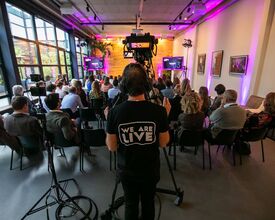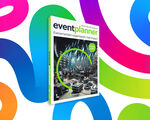Most people now agree: a hybrid event actually consists of 2 separate events - a live and an online event. Yet for many event pros, this 'dichotomy' starts with program design and production. But if you only then start to think from multiple target groups, you have already skipped steps. Where is the blind spot in hybrid events?
Momice has the answer and wrote a very interesting blog post about the pitfalls of organizing hybrid events. We are happy to share it with you:
Who goes where? This is pure relationship management!
Who can attend live? And who do you want to invite to the online part? Being present live can offer added value. Let's take a look at Apple's product launches. They have always been hybrid for corona. Long-range journalists and important ambassadors were invited to attend live and view the new products afterwards. The strategy behind this? Exclusivity leads to great PR value. In addition, all fans and potential customers are retained because they can watch live.
TED has also been using a hybrid variant for years. Even though there is still something to be gained in terms of interaction and online experience, they have always succeeded in generating exclusivity. The strategy behind this is based on a strong substantive audience and therefore an interesting network as the most important added value for live participation. The result: people love to pay a few thousand euros for a ticket.
In short: the (network) strategy of your organization is leading for the target group choice of a hybrid event. The main target audience will get 'the cream of the crop' at the live event - while others can watch or participate in the online section. How about your events?
Check for yourself:
- Is there a network strategy in your organization?
- Are the (differences in) target groups clear in advance?
- Do you determine in advance who may or may not be present live?
- Or can the invitee choose himself?
- How many places do you have available at both events?
- Are participants allowed to bring someone (live / online)
- Do you use different tickets and / or prices for both parts?
- Who in your organization is the point of contact for the two target groups?
One goal is not enough
Are clear objectives set for events within your organization? And is one objective formulated for a hybrid event? Or do you split this into two separate objectives: live and online? When you use different target groups, it is logical that the objectives also differ.
Each target group has its own needs and obstacles. You can take this into account in the communication (read more about this later in this article), but also in the choice of the format and design of your program.
Hybrid formats
Over the past year we have learned a lot about formats that work well online. But do those formats also work for your audience in the room? Perhaps a talk show is not that engaging for your live audience.
Events with one clear element, such as a product presentation, can be used perfectly for both target groups. But if you have a longer or more complex program, you can greatly improve the experience by alternating different short formats. This is called a Magazine format. Think of speakers on the stage, videos, panel discussions, etc. Always consider what the viewer will see on the screen, but do not lose sight of the 'decor' in the room.
Also try to imagine how online viewers participate in your hybrid events. Do they watch their laptop in between? Or together with colleagues? Viewers parties are organized for some events: small groups watch the (plenary part of) the online event together. As an organizer you can also stimulate the organization of viewers' parties (for example in the invitation or on the event website).
Hybrid program
Once you have established your format (s), you can start designing the program. A lot has already been written about this, which is why we have visualized a possible hybrid program with the different target groups:
As you can see, only a few parts are the same for both target groups. All light-colored blocks indicate which parts differ - and for which a separate program and script must be made.
Collaborative interaction
As you can see in the image above, you focus the audience interaction on both audiences. Think carefully about how you want to use the interaction. Can the participants from the audience also vote on the same polls? Or do you want to show the difference on the screen (so two different target groups). And which tools do you use for this?
Remember, audience interaction is not a 'gimmick' that you only add at the end, but an essential part that needs to be integrated and designed from the start.
The blind spot: registration and communication
The invitation is the first point of contact with your target group (s). To make sure you make the right promise to the right people, it is essential that the program and content are established before you send out the invitation.
Ask yourself the following questions:
- How do you split the registration and communication of your target group? With different tickets, a question in the form or 2 different events your event software?
- Can guests choose what they sign up for?
- What happens to the registration of a live participant who still wants to participate online or vice versa?
- How do you deal with the guest list? Do you open it to all participants? Or just for a live audience?
- How do you deal with break-out or workshop registrations? And how do the online participants get the right links?
- Is there a maximum number of participants for 1 of the 2 parts? Are you setting up a reserve list?
- How do you ensure the correct communication and updates for both target groups?
As you can see, communication with a hybrid event can become quite complex. Good software and tools are indispensable in this process!
Data and evaluation: separate or separate?
How do you determine the success of the event afterwards? You should have set goals for the live and online part. Do you evaluate everything at once? Or do you divide the evaluation into two parts? What data is available for both evaluations? And how do you collect these? The right software can help you collect:
- NPS (Net Promoter Score)
- Average rating event
- Open event survey feedback
- Results from polls
- Viewer data
- Show & no-show at the live part
- Workshop participation (live & online)
These tools & technique are essential
Now that you know where the blind spot is when organizing a hybrid event, you can also better estimate which platforms or software you need to allow both target groups to participate effortlessly. We list a few things that you cannot ignore:
- Registration software (mailings, tickets, website, live stream page)
- Livestream tool (to be provided yourself or via a livestream partner)
- Interaction tools (polls, chats)
- Platform for online breakouts (including guidance to the next session)
- Evaluation tools (event survey, viewer data, online & offline check-in and check-out)
In short: you need professional tools to ensure smooth participation for both target groups. Carefully thinking through each step must be done very accurately for a hybrid event and without professional event software, chances are that it will become one big chaos. It is therefore really important to think in advance about the right steps and associated tools.
Dutch
Inmiddels zijn de meeste mensen er wel over eens: een hybride event bestaat eigenlijk uit 2 losse events - een live en een online event. Toch begint deze 'tweedeling' voor veel event pro's bij het ontwerpen van het programma en de productie. Maar als je dan pas begint te denken vanuit meerdere doelgroepen, heb je al stappen overgeslagen. Waar zit de blinde vlek bij hybride events?
Momice heeft het antwoord en schreef een razend interessante blogpost over de valkuilen bij het organiseren van hybride events. We delen hem graag met je:
Wie komt waar? Dit is puur relatiemanagement!
Wie mag live aanwezig zijn? En wie wil je voor het online gedeelte uitnodigen? Live aanwezig zijn kan meerwaarde bieden. Laten we eens kijken naar de product launches van Apple. Die waren voor corona ook altijd al hybride. Journalisten met een groot bereik en belangrijke ambassadeurs werden uitgenodigd om live aanwezig te zijn en naderhand de nieuwe producten te bekijken. De strategie hierachter? Exclusiviteit leidt tot grote PR-waarde. Daarnaast worden alle fans en potentiële klanten behouden doordat ze live kunnen meekijken.
Ook TED hanteert al jaren een hybride variant. Ook al valt op het gebied van interactie en online beleving nog wel wat te winnen, ze zijn er altijd goed in geslaagd om exclusiviteit te genereren. De strategie hierachter is gebaseerd op een sterk inhoudelijk publiek en daarmee een interessant netwerk als belangrijkste meerwaarde voor live deelname. Gevolg: mensen betalen met liefde een paar duizend euro voor een kaartje.
Kortom: de (netwerk)strategie van jouw organisatie is leidend voor de doelgroepkeuze van een hybride event. De belangrijkste doelgroep krijgt 'het neusje van de zalm' op het live event - terwijl anderen kunnen meekijken of meedoen aan het online gedeelte. Hoe zit dit bij jouw events?
Ga voor jezelf eens na:
- Is er een netwerkstrategie aanwezig in jouw organisatie?
- Zijn de (verschillen in) doelgroepen vooraf duidelijk?
- Bepaal jij vooraf wie er wel/niet live aanwezig mag zijn?
- Of mag de genodigde zelf kiezen?
- Hoeveel plaatsen heb je beschikbaar bij beide events?
- Mogen deelnemers iemand meenemen (live/online)
- Hanteer je verschillende tickets en/of prijzen voor beide onderdelen?
- Wie in jouw organisatie is het aanspreekpunt voor de twee doelgroepen?
Eén doelstelling is niet genoeg
Worden er binnen jouw organisatie duidelijke doelstellingen gemaakt voor events? En wordt er voor een hybride event één doelstelling geformuleerd? Of splits je deze uit in twee aparte doelstellingen: live en online? Wanneer je verschillende doelgroepen hanteert, is het logisch dat ook de doelstellingen verschillen.
Elke doelgroep heeft zijn eigen behoeften en belemmeringen. Hier kun je rekening mee houden in de communicatie (lees hierover meer verderop in dit artikel), maar ook in de keuze voor het format en het ontwerp van je programma.
Hybride formats
Het afgelopen jaar hebben we veel geleerd over formats die online goed werken. Maar werken die formats ook voor je publiek in de zaal? Misschien is een talkshow niet zo boeiend voor je live publiek.
Events met één duidelijk onderdeel, bijvoorbeeld een productpresentatie, kan prima worden ingezet voor beide doelgroepen. Maar wanneer je een langer of complexer programma hebt, kun je de beleving sterk verbeteren door het afwisselen van verschillende korte formats. Dit wordt een Magazine format genoemd. Denk hierbij aan sprekers op het podium, video’s, paneldiscussies etc. Bedenk hierbij altijd wat de kijker op het scherm te zien krijgt, maar verlies ook het 'decor' in de zaal niet uit het oog.
Probeer je ook voor te stellen hoe online kijkers aan jouw hybride events deelnemen. Kijken zij tussendoor op hun laptop? Of samen met collega's? Voor sommige events worden viewers parties georganiseerd: hierbij kijken kleine groepen samen naar het (plenaire gedeelte van) het online event. Als organisator kun je ook het organiseren van viewers parties stimuleren (bijvoorbeeld in de uitnodiging of op de event website).
Hybride programma
Zodra je jouw format(s) hebt vastgesteld, kun je het programma gaan ontwerpen. Hier is al veel over geschreven, daarom hebben we een mogelijk hybride programma met de verschillende doelgroepen gevisualiseerd:
Zoals je kunt zien zijn er slechts een aantal onderdelen hetzelfde voor beide doelgroepen. Alle lichtgekleurde blokken geven aan welke onderdelen verschillen - en waar dus een apart programma en script voor gemaakt moet worden.
Gezamenlijke interactie
Zoals je kunt zien in bovenstaande afbeelding richt je de publieksinteractie op beide doelgroepen. Denk goed na hoe je de interactie wilt inzetten. Kunnen je de deelnemers uit de zaal ook stemmen op dezelfde polls? Of wil je juist het onderscheid laten zien op het scherm (dus twee verschillende doelgroepen). En welke tools gebruik je hiervoor?
Onthoud: publieksinteractie is geen 'gimmick' is die je pas aan het einde toevoegt, maar een essentieel onderdeel dat vanaf het begin moet worden geïntegreerd en ontworpen.
##asset-334##
De blinde vlek: registratie en communicatie
De uitnodiging is het eerste contactpunt met je doelgroep(en). Om ervoor te zorgen dat je de juiste belofte doet aan de juiste mensen is het essentieel dat het programma en de inhoud vast staan vóórdat je de uitnodiging verstuurt.
Stel jezelf hierbij de volgende vragen:
- Hoe splits je de registratie en communicatie van je doelgroep? Met verschillende tickets, een vraag in het formulier of 2 verschillende events jouw event software?
- Kunnen gasten zelf kiezen waar ze zich voor inschrijven?
- Wat gebeurt er met de registratie van een live deelnemer die toch online wil meedoen of andersom?
- Hoe ga je om met de gastenlijst? Stel je die open voor alle deelnemers? Of alleen voor live publiek?
- Hoe ga je om met break-out of workshopregistraties? En hoe krijgen de online deelnemers de juiste links?
- Geldt er een maximum aantal deelnemers voor 1 van de 2 onderdelen? Stel je een reservelijst in?
- Hoe zorg je voor de juiste communicatie en updates voor beide doelgroepen?
Zoals je ziet kan de communicatie bij een hybride event behoorlijk complex worden. Goede software en tools zijn onmisbaar bij dit proces!
Data en evaluatie: apart of gescheiden?
Hoe bepaal je achteraf het succes van het event? Als het goed is heb je doelstellingen geformuleerd voor het live en het online gedeelte. Evalueer je alles in één keer? Of knip je de evaluatie op in twee onderdelen? Welke data is er beschikbaar voor beide evaluaties? En hoe verzamel je deze? De juiste software kan je helpen bij het verzamelen van:
- NPS (Net Promoter Score)
- Gemiddelde waardering event
- Open feedback uit event enquête
- Resultaten uit polls
- Kijkersdata
- Show & no-show bij het live gedeelte
- Workshopdeelname (live & online)
Deze tools & techniek zijn essentieel
Nu je weet waar de blinde vlek zit bij het organiseren van een hybride event, kun je ook beter inschatten welke platformen of software je nodig hebt om beide doelgroepen moeiteloos te laten deelnemen. We noemen een paar zaken waar je niet omheen kunt:
- Registratiesoftware (mailings, tickets, website, livestreampagina)
- Livestream tool (zelf te verzorgen of via een livestream partner)
- Interactietools (polls, chats)
- Platform voor online break-outs (inclusief begeleiding naar de volgende sessie)
- Evaluatietools (event enquête, kijkersdata, online & offline in-en uitchecken)
Kortom: om te zorgen voor een soepele deelname voor beide doelgroepen heb je professionele tools nodig. Het goed doordenken van elke stap moet voor een hybride event heel nauwkeurig gebeuren en zonder professionele event software is de kans groot dat het één grote chaos wordt. Het is daarom echt belangrijk om van tevoren na te denken over de juiste stappen en bijbehorende tools.
Meld je aan: webinar hybride events
In de Momice Webinar hybride events gaat Momice dieper op dit onderwerp in.
Lees meer en schrijf je in







